
The Break-Even Point (BEP) is the inflection point at which the revenue output of a company is equal to its total costs and starts to generate a profit. For the example of Maggie’s Mugs, she paid $5 per mug and $10 for them to be painted. If she keeps falling short of the 500 units needed to break even, she could potentially find a cheaper mug supplier or painters who are willing to take a lesser payment.
Calculating Contribution Margin and BEPs
We will also explore how to effectively use Excel for your calculations, making financial forecasting simpler and more accurate. One of the many challenges of being a small business owner is making sure your revenue at least balances out your expenses. After months, if not years of investment, you want your business to sustain itself with its own money. Using our Break-Even Point Calculator, you can quickly and easily calculate your break-even point and make informed decisions about your business finances. Having a successful business can be easier and more achievable when you have this information.
What is your current financial priority?
This means Sam needs to sell just over 1800 cans of the new soda in a month, to reach the break-even point. Sales Price per Unit- This is how much a company is going to charge consumers for just one of the products that the calculation is being done for. Break-even sales are the dollar amount of revenue at which a business earns a profit of zero. Selecting the right tool depends on the complexity of the business’s financial model and the need for ongoing updates or detailed analysis. Businesses with more complex financial operations may benefit from using accounting software that integrates break-even analysis into its suite of financial tools. Programs such as QuickBooks, Xero, or FreshBooks offer break-even analysis as part of their reporting functions.
How can I account for updates and maintenance costs in my break-even analysis?
Small business owners can use the calculation to determine how many product units they need to sell at a given price point to break even. A break-even analysis relies on three crucial aspects of a business operation – selling price of a unit, fixed costs and variable costs. On the other hand, variable costs are largely dependent on the volume of work at hand – if you have more clients, you will need more labor and materials which results in an increase in variable expenses. The total fixed costs are $50k, and the contribution margin ($) is the difference between the selling price per unit and the variable cost per unit. So, after deducting $10.00 from $20.00, the contribution margin comes out to $10.00. The difference between sales price per unit and variable costs per unit is the contribution margin of your business.
- These are questions we frequently receive from entrepreneurs who have downloaded the business plan for a mobile app.
- In conclusion, just like the output for the goal seek approach in Excel, the implied units needed to be sold for the company to break even come out to 5k.
- If your sales price is too low, you might have to sell too many units to break even.
- Excel allows users to create detailed financial models with formulas that automatically calculate the break-even point when key variables such as fixed costs, variable costs, and selling prices are input.
If a business’s revenue is below the break-even point, then the company is operating at a loss. BEP is also known as the cost-covering point or the profit threshold. As a key performance indicator (KPI), it represents independent the point at which a company’s total revenues and expenses balance each other out. It’s a critical financial metric determining when your revenue will cover all your costs, leaving you neither in profit nor loss.
Why You Can Trust Finance Strategists
After almost a decade of experience in public accounting, he created MyAccountingCourse.com to help people learn accounting & finance, pass the CPA exam, and start their career. Let us go through a break-even analysis step by step to illustrate its usefulness with a real-life example of starting a business. The incremental revenue beyond the break-even point (BEP) contributes toward the accumulation of more profits for the company. If a company has reached its break-even point, the company is operating at neither a net loss nor a net gain (i.e. “broken even”).

Learn more about Bench, our mission, and the dedicated team behind your financial success. The magic happens when our intuitive software and real, human support come together. Book a demo today to see what running your business is like with Bench. Andy Smith is a Certified Financial Planner (CFP®), licensed realtor and educator with over 35 years of diverse financial management experience.
App store fees, typically around 30% of revenue, are a variable cost that must be considered in break-even calculations. Revenue per download can be calculated by dividing total revenue by the number of downloads. Imagine you are developing a mobile app and want to calculate the break-even point in terms of downloads. A break-even analysis allows you to determine your break-even point.
When you know exactly how many units you need to sell to reach the break even point, it becomes easier to plan ahead of the time. So, your break even plan will form your datum point at which you become profitable. Achieving 5% may well be the disired growth rate to allow the business to succeed, achieving 10% or 20% would facilitate excellent business growth. Knowing this allows you to set targets for your sales teams and provide incentives for them (financial, promotion, shares etc.). Quantifying the success rates allows those with drive and determination to push to achieve the highest levels which is great for personal achievement, financial reward and overall business success.